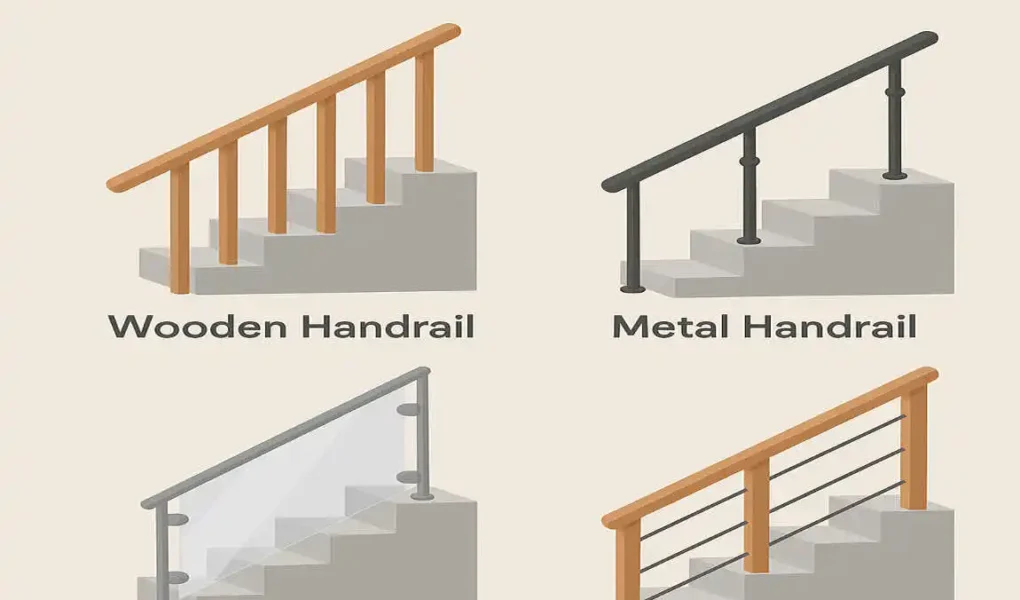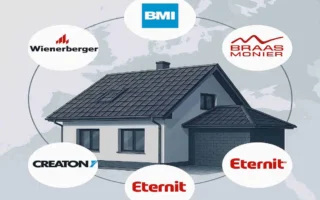Have you ever paused at the top of a staircase and appreciated that sturdy rail beneath your hand? House handrails might seem like simple fixtures, but they’re actually the unsung heroes of home safety and style. These essential elements do double duty in our homes, keeping us safe from tumbles while adding that perfect finishing touch to our interior design.
When we talk about types of house handrails, we’re diving into a world where function meets fashion. Whether you’re building a new home, renovating an existing space, or simply looking to upgrade your current setup, choosing the right handrail can transform both the safety and aesthetic appeal of your living space.
Importance of House Handrails

Think about the last time you navigated stairs in the dark or watched a toddler climb steps for the first time. Handrails provide that essential point of contact that keeps us grounded and secure. They’re particularly crucial for children still developing their balance and coordination, as well as for elderly family members who may need extra support.
The safety benefits extend beyond just preventing falls. A well-placed handrail gives people confidence to move freely around their homes. It’s that psychological comfort of knowing support is always within reach. Statistics show that falls are among the leading causes of home injuries, and proper handrails can reduce these incidents by up to 50%.
Building codes aren’t just bureaucratic red tape – they exist for good reason. Most jurisdictions require handrails for any staircase with four or more risers. The typical height requirement ranges from 34 to 38 inches from the stair nosing. These regulations ensure that every home maintains a baseline level of safety for all occupants and visitors.
Beyond safety, handrails significantly boost your home’s market value. Real estate professionals often note that homes with stylish, well-maintained handrails make a better first impression during showings. They signal to potential buyers that the house has been well-maintained and meets all safety standards.
Key Factors to Consider When Choosing House Handrails
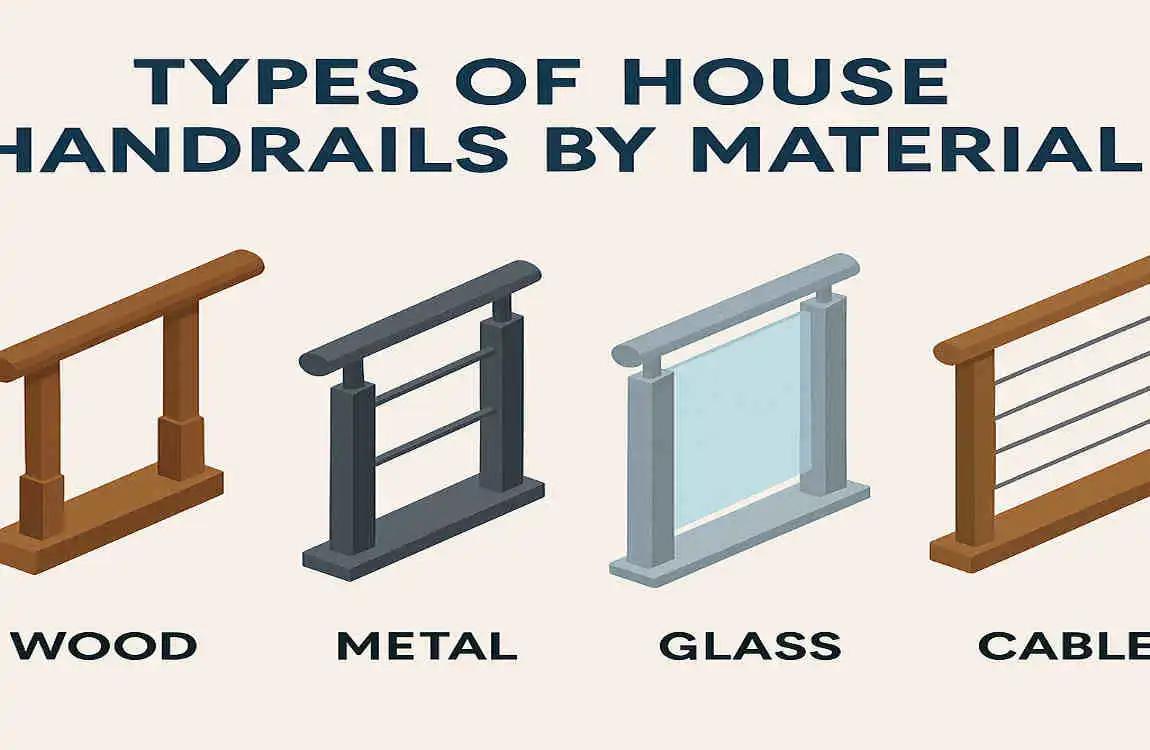
Selecting the perfect handrail isn’t just about picking what looks good in the showroom. Material durability should top your list of considerations. Ask yourself: Will this handrail withstand daily use for years to come? Different materials age at different rates, and your choice should reflect your lifestyle and maintenance preferences.
Your home’s existing design language plays a crucial role in handrail selection. An ultra-modern glass rail might look stunning in a contemporary loft, but could clash terribly with a traditional Colonial home. Style compatibility ensures your new handrails enhance rather than detract from your overall aesthetic.
Safety standards aren’t negotiable—they’re essential. The handrail must be grippable, typically with a diameter between 1.25 and 2 inches. Height requirements vary slightly by region, but generally fall within that 34-38 inch range mentioned earlier. Don’t forget the spacing between balusters; it shouldn’t allow a 4-inch sphere to pass through.
Budget considerations often determine the final choice. While it’s tempting to go for the cheapest option, remember that handrails are a long-term investment—factor in not just the initial cost but also maintenance expenses over time. Sometimes spending a bit more upfront saves money in the long run.
Installation complexity varies dramatically between handrail types. Some wooden rails come as complete kits perfect for DIY enthusiasts, while custom glass installations almost always require professional help. Be honest about your skill level and available time before committing to a particular style.
Types of House Handrails by Material

Wood Handrails
There’s something inherently comforting about wooden handrails. They bring warmth and character to any space, creating that timeless appeal that never really goes out of style. The natural grain patterns and warm tones of wood make each handrail unique, almost like a piece of functional art.
Popular wood choices each bring their own personality to your home. Oak stands out for its durability and distinctive grain patterns. It’s the workhorse of wooden handrails, capable of withstanding decades of use. Maple offers a lighter, more contemporary look with its subtle grain and excellent staining properties. Pine provides an affordable option for painted finishes, while cherry develops a rich patina over time that many homeowners treasure.
The advantages of wooden handrails extend beyond aesthetics. They’re relatively easy to customize – need a specific length or curve? A skilled carpenter can make it happen. Wood feels naturally warm to the touch, making it comfortable in all seasons. Plus, minor damages can often be sanded out and refinished, giving wooden rails impressive longevity.
However, wood does demand some attention. Regular maintenance includes periodic polishing and sealing to protect against moisture and wear. In high-humidity areas, wood can warp or crack without proper treatment. You’ll need to commit to annual inspections and touch-ups to keep wooden handrails looking their best.
Metal Handrails
Step into the world of metal handrails, and you’ll find options ranging from ornate Victorian wrought iron to sleek contemporary stainless steel. Each metal type brings distinct advantages and aesthetic qualities to your home.
Wrought iron handrails evoke old-world charm with their potential for intricate house designs and scrollwork. They’re powerful and can last for generations with proper care. Stainless steel represents the pinnacle of modern design – clean, minimalist, and virtually maintenance-free. Aluminum offers a lightweight alternative that’s perfect for outdoor applications where rust resistance is crucial.
The durability of metal handrails is practically legendary. They can withstand heavy use, resist impact damage, and maintain their structural integrity for decades. Most metal options require minimal maintenance—just occasional cleaning to maintain their appearance—and their sleek, modern designs work particularly well in contemporary homes.
On the downside, metal can feel cold to the touch, especially in winter. This might be uncomfortable for some users, particularly elderly individuals with arthritis. While stainless steel resists rust, other metals may require protective coatings that need periodic renewal. The industrial appearance of some metal handrails might not suit every home’s aesthetic.
Glass Handrails
Glass handrails represent the cutting edge of modern home design. They create an illusion of space and allow light to flow freely through your home. When you want to maintain sight lines or showcase a beautiful view, glass becomes the material of choice.
These handrails typically combine tempered safety glass panels with metal or wood frames for support. The glass itself undergoes special treatment to ensure it’s strong enough for daily use and safe in the event of breakage. Modern glass handrails can be completely clear, frosted for privacy, or even tinted to complement your color scheme.
The visual benefits are immediately apparent. Glass maximizes natural light, making spaces feel larger and more open. It works beautifully in homes with scenic views, as it doesn’t obstruct the landscape. The contemporary aesthetic suits modern architecture perfectly, creating that magazine-worthy look many homeowners desire.
Cost considerations can’t be ignored with glass handrails. They typically represent a significant investment, both in materials and professional installation. Frequent cleaning is necessary to maintain their pristine appearance – fingerprints and smudges show easily. Some homeowners also worry about the psychological barrier effect, as glass can feel less secure than solid materials, even though it is perfectly safe.
Plastic and Composite Handrails
Don’t dismiss plastic and composite handrails as inferior options. Modern manufacturing has produced composite materials that rival traditional materials in both appearance and performance. These engineered solutions offer unique advantages that make them perfect for specific applications.
Composite handrails blend wood fibers with synthetic materials to create products that look like wood but perform like plastic. They resist moisture, insects, and rot without the constant maintenance required by natural wood. Vinyl handrails provide similar benefits with even lower maintenance requirements.
The affordability factor makes these materials accessible to more homeowners. They’re particularly excellent for outdoor applications where weather resistance is paramount. The variety of colors and textures available means you can find options that complement any design scheme. Installation is often more straightforward than with traditional materials, making them DIY-friendly.
The trade-offs include a less luxurious feel compared to natural materials. Some composites can fade or become brittle with prolonged exposure to sunlight. While technology continues to improve, discerning eyes can still distinguish composite from real wood or metal. For many homeowners, though, the practical benefits outweigh these aesthetic considerations.
Rope Handrails
Rope handrails bring nautical charm and rustic appeal to the right setting. They’re not just for beach houses anymore – creative designers incorporate rope elements into farmhouse, industrial, and even modern designs with stunning results.
These handrails typically feature thick marine-grade rope threaded through metal or wood posts. The rope itself might be natural hemp for authentic texture or synthetic materials for improved durability. Some designs incorporate knots as decorative elements, while others keep things simple with straight runs.
The rope’s unique aesthetic can’t be replicated with other materials. It adds texture and visual interest while maintaining a casual, relaxed atmosphere. Rope handrails work particularly well in coastal properties, lake houses, or any space where you want to evoke a connection to maritime traditions. They’re also surprisingly flexible during installation, adapting to curves and angles that might challenge rigid materials.
Durability concerns are real with rope handrails. Even high-quality rope will eventually fray or stretch, requiring periodic tightening or replacement. They may not meet building codes in all jurisdictions, particularly for primary staircases. The informal appearance might also clash with more formal interior designs.
Types of House Handrails by Design Style

Traditional Handrails
Traditional handrails embody the elegance of classical architecture. Picture the grand staircases of historic mansions with their ornate balusters and gracefully curved rails. These designs draw inspiration from centuries of architectural tradition, bringing timeless sophistication to modern homes.
The hallmark of traditional handrails lies in their attention to detail. Ornate carvings, turned balusters, and decorative newel posts create visual interest at every angle. Common motifs include acanthus leaves, rope patterns, and geometric designs that have graced homes for generations. The curves flow naturally, guiding your hand and eye along the staircase.
Wood and wrought iron dominate traditional handrail construction. These materials lend themselves to the intricate detailing that defines the style. Rich wood stains highlight natural grain patterns, while painted finishes in classic white or black create crisp, formal looks. Wrought iron allows for elaborate scrollwork that adds drama and sophistication.
Traditional handrails perfectly complement Victorian, Colonial, Georgian, and other heritage home styles. They create continuity with original architectural features and maintain the historical integrity of older properties. Even in newer homes, traditional handrails can add a sense of established elegance and permanence.
Modern/Contemporary Handrails
Clean lines and minimalist aesthetics define modern handrails. These designs strip away unnecessary ornamentation to focus on form and function. The result? Handrails that make bold statements through simplicity rather than complexity.
Contemporary handrails often feature horizontal lines instead of traditional vertical balusters. Cable systems, glass panels, or widely spaced horizontal bars create an open, airy feel. Materials are left in their natural state – brushed steel, clear glass, natural wood – celebrating their inherent beauty without embellishment.
The marriage of metal and glass epitomizes modern handrail design. Stainless steel posts support frameless glass panels for an almost invisible barrier. Alternatively, tensioned cable systems provide safety without blocking views. These combinations work beautifully in condos, lofts, and contemporary homes where maximizing light and space is paramount.
Modern handrails complement today’s open floor plans perfectly. They maintain sight lines between spaces while providing necessary safety features. The understated elegance suits minimalist interiors where every element serves a purpose without adding visual clutter.
Industrial Handrails
Industrial handrails celebrate raw materials and utilitarian design. This style emerged from converted warehouses and factories, where existing infrastructure became decorative features. Now, homeowners deliberately choose industrial elements to create edgy, urban atmospheres.
The aesthetic embraces imperfection and functionality. Exposed welds, visible bolts, and unfinished metals are features, not flaws. Black iron pipes, reclaimed steel beams, and galvanized fittings combine to create handrails that look like they belong in a working factory. The beauty lies in the honest expression of materials and construction methods.
Industrial handrails pair naturally with exposed brick walls, concrete floors, and visible ductwork. They’re particularly popular in loft conversions and urban renovations where maintaining the building’s industrial heritage is essential. The style also works surprisingly well in modern farmhouse designs, adding a contemporary edge to rustic elements.
Creating authentic industrial handrails often involves sourcing genuine industrial components. Plumbing pipes, scaffolding clamps, and steel mesh panels find new life as residential safety features. This repurposing appeals to environmentally conscious homeowners who appreciate sustainable design practices.
Rustic and Farmhouse Handrails
Rustic handrails bring the outdoors inside with natural materials and organic forms. These designs celebrate imperfection – the knot in the wood, the irregular branch shape, the weathered patina. They create warm, inviting spaces that feel connected to nature.
Natural wood takes center stage in rustic designs. Rough-hewn beams, live-edge boards, and branches with bark intact all find places in rustic handrails. The wood might be reclaimed from old barns, adding history and character to new constructions. Finishes range from natural oils that enhance grain to whitewashed treatments that create shabby-chic appeal.
Farmhouse handrails blend rustic elements with practical design. They might combine rough wood rails with simple metal balusters, or incorporate rope elements for added texture. The overall effect is casual yet intentional—comfortable spaces where family and friends naturally gather.
These handrails work beautifully in country homes, mountain cabins, and suburban houses seeking a connection to simpler times. They complement stone fireplaces, exposed beams, and other natural elements that define rustic and farmhouse aesthetics.
Artistic and Custom Handrails
When standard options won’t do, artistic handrails become functional sculptures. These one-of-a-kind creations transform staircases into gallery-worthy installations that reflect personal style and creativity.
Custom handrails might incorporate laser-cut metal panels depicting nature scenes, abstract patterns, or family crests. Hand-forged iron can twist into organic shapes that seem to grow from the stairs themselves. Glass artists create panels with embedded colors, textures, or images that catch light throughout the day.
The possibilities are truly limitless. Some homeowners commission hand-carved wooden rails featuring their favorite animals or plants. Others work with metal artists to create handrails that double as light sculptures, incorporating LED strips or fiber optics. Mixed media designs might combine wood, metal, glass, and even stone in unexpected ways.
While artistic handrails make powerful design statements, they require careful planning. You’ll need to work closely with artists and craftspeople to ensure designs meet safety codes while achieving your vision. Budget accordingly – custom work requires significant investment but creates truly unique living spaces.
Handrails for Different Areas of the House
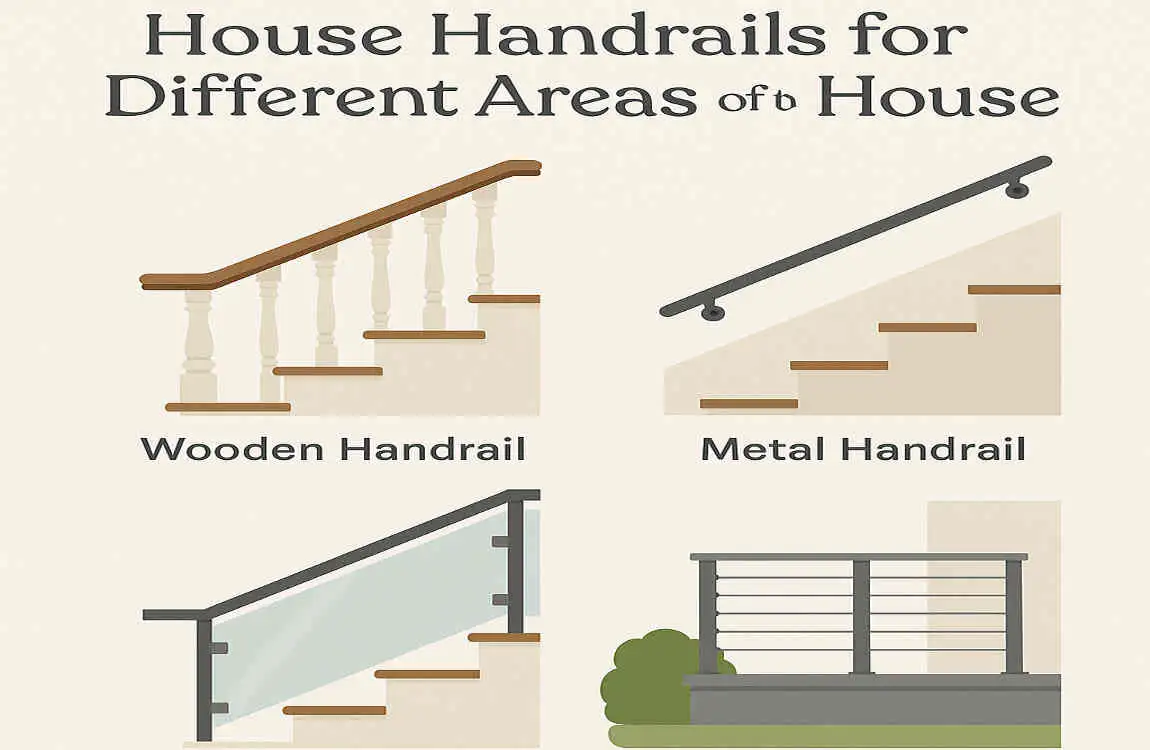
Different areas of your home demand different handrail solutions. What works perfectly for an indoor staircase might fail miserably on an exposed deck. Let’s explore the specific requirements for various locations.
Stairway handrails bear the heaviest use and strictest code requirements. They need to be continuous, allowing hands to slide smoothly from top to bottom without interruption. The grip must be comfortable for extended use, and the mounting must withstand significant lateral force. Consider traffic patterns – a main staircase requires more durable materials than a rarely used attic access.
Balconies and terraces present unique challenges. Outdoor exposure means materials must resist weather, UV rays, and temperature fluctuations. The handrails must be tall enough to prevent falls from height – typically 42 inches for elevated decks. Glass panels or cable systems work well here, preserving views while providing safety.
Porches and decks require weather-resistant materials that can handle rain, snow, and sun. Composite materials excel in these applications, as do properly treated woods and powder-coated metals. Consider how the handrails will look from both inside and outside your home, as they contribute to curb appeal.
Bathroom handrails serve a special purpose. These safety-focused installations must resist moisture and provide secure gripping surfaces even when wet. Textured surfaces, appropriate mounting heights, and strategic placement near tubs, showers, and toilets can prevent dangerous slips and falls.
Installation and Maintenance Tips for House Handrails

The eternal question: should you tackle handrail installation yourself or call in the professionals? DIY installation can save money and provide satisfaction, but it’s not for everyone. Simple wooden handrail kits with clear instructions suit handy homeowners. You’ll need basic tools like a drill, level, and saw, plus the patience to measure twice and cut once.
Professional installation makes sense for complex projects. Glass handrails, custom metalwork, and any installation requiring structural modifications deserve expert attention. Professionals bring specialized tools, experience with building codes, and insurance coverage if something goes wrong. They can also spot potential problems that might escape the notice of amateurs.
Here’s a practical comparison to help you decide:
Installation Factor DIY Approach Professional Installation
Cost Materials only ($200-$800) Materials + Labor ($500-$3000+)
Time Required: 1-3 days for an average project, 4-8 hours typically
Skill Level Needed: Intermediate to Advanced. No skill required from the homeowner
Tools Required: $100- $300 in tools, if not owned. All tools provided
Code Compliance: Your responsibility is to research guaranteed compliance
Warranty Materials only, Installation and materials
Risk Factor: Higher risk of errors, Minimal risk
Basic installation requires several essential tools—a quality drill with various bits handles most mounting tasks. A level ensures handrails run true – crooked rails look unprofessional and might not meet code. Measuring tools, including a tape measure and, for longer runs, a laser level, ensure accurate placement. Don’t forget safety equipment, such as goggles and gloves.
Regular maintenance varies by material but follows some universal principles. Weekly cleaning prevents the buildup of dirt and grime that can cause premature wear. Use appropriate cleaners – harsh chemicals can damage finishes or etch glass. Wooden rails need periodic refinishing, typically every 2-3 years, depending on use and exposure.
Create a maintenance schedule that includes:
- Monthly visual inspections for loose mountings or damage
- Quarterly deep cleaning with appropriate products
- Annual professional inspection for structural integrity
- Periodic refinishing based on material requirements
Safety Standards and Regulations for House Handrails
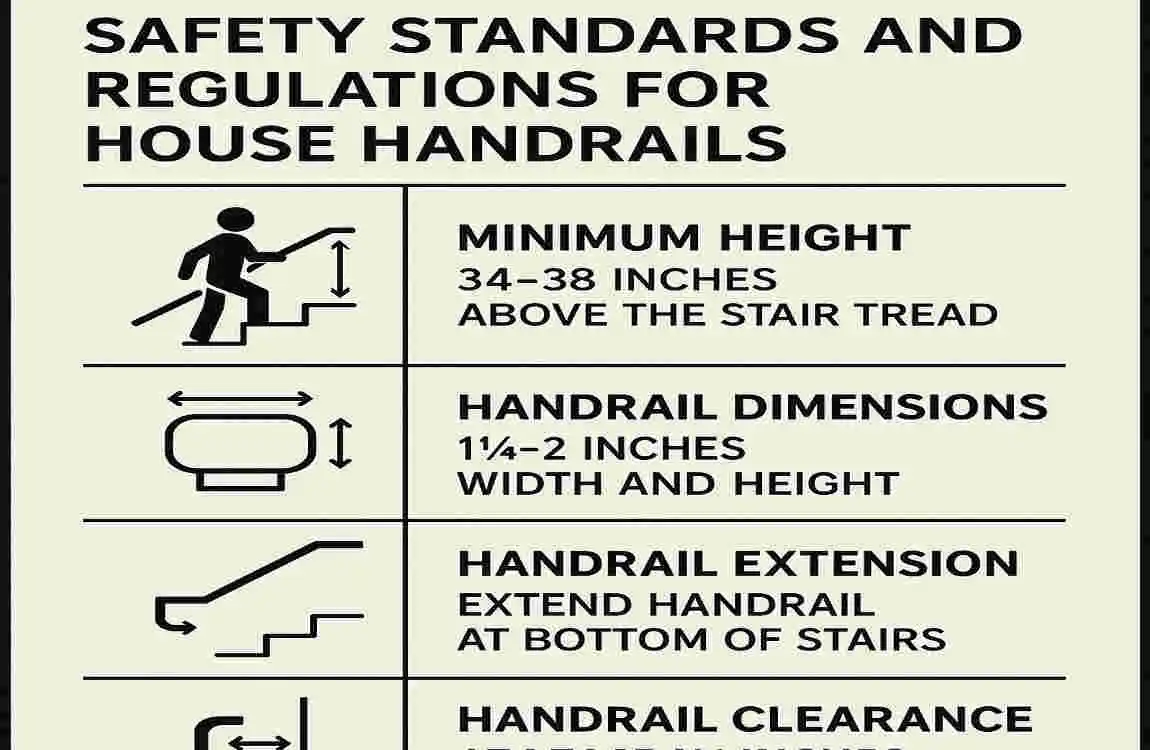
Building codes aren’t suggestions—they’re legal requirements that ensure your home is safe for everyone. Height requirements typically specify handrails between 34 and 38 inches measured vertically from the stair nosing. This range accommodates most adults while remaining accessible for children who need support.
The spacing between balusters follows the “4-inch sphere rule.” No opening should allow a 4-inch sphere to pass through, preventing small children from getting stuck or falling through gaps. This applies to horizontal and vertical spaces throughout the handrail system.
Load-bearing requirements ensure handrails can actually protect people from falls. Most codes require handrails to withstand 200 pounds of force applied in any direction. The mounting system must transfer this load to the building structure without failing. This is why proper anchoring to studs or the use of appropriate hollow-wall anchors is crucial.
Graspability standards ensure people can maintain secure holds. Handrail profiles must allow fingers to wrap around at least three-quarters of the rail. Acceptable shapes include circular rails between 1.25 and 2 inches in diameter, or other profiles with equivalent gripping surfaces. Square or rectangular rails need rounded edges for comfort and safety.
ADA compliance adds another layer of accessibility requirements. These standards ensure people with disabilities can safely navigate stairs. Key requirements include:
- Continuous handrails without interruptions
- Extensions at the top and bottom of the stairs
- Consistent height throughout the run
- Smooth surfaces free from sharp edges
Different jurisdictions may have additional requirements. Coastal areas might specify corrosion-resistant materials. Earthquake-prone regions could require stronger mounting systems. Historic districts might limit style options to maintain architectural consistency. Always check local codes before beginning any handrail project.
Trending Innovations in House Handrails

The future of handrails is here, and it’s more exciting than you might expect. Innovative handrails integrate technology to enhance both safety and convenience. LED strips embedded in handrails provide automatic lighting along the pathway, triggered by motion sensors. Imagine navigating stairs at night with soft illumination guiding your way – no fumbling for light switches required.
Some innovative systems include pressure sensors that detect when someone grips the rail, potentially alerting caregivers if an elderly resident needs assistance. Temperature-sensitive materials change color to indicate whether the rails are too hot or too cold to touch comfortably. These features seem futuristic, but are becoming increasingly available to homeowners.
Sustainability drives many current innovations. Manufacturers now offer handrails made from rapidly renewable bamboo, recycled metals, and reclaimed plastics. These eco-friendly options don’t compromise on style or safety. In fact, many sustainable materials offer superior performance characteristics, such as natural antimicrobial properties or enhanced durability.
The sourcing of materials matters too. Certified sustainable wood from responsibly managed forests provides peace of mind. Recycled aluminum and steel reduce environmental impact while maintaining strength and aesthetics. Some companies even offer take-back programs that recycle old handrails into new products.
Modular systems represent another exciting trend. These handrails come in standardized sections that snap or bolt together, allowing homeowners to customize configurations without custom fabrication. Need to extend a handrail? Add another module. Want to change from straight to curved? Swap in appropriate sections. This flexibility makes renovations simpler and more affordable.
Adjustable handrail systems accommodate changing needs. Telescoping designs extend or contract to fit various stair configurations. Height-adjustable options can be modified as children grow or accessibility needs change. Some systems even allow you to change materials or styles by swapping components rather than replacing entire installations.
Trending Innovations in House Handrails FAQ
What are smart handrails and how do they work?
Smart handrails represent the intersection of home safety and modern technology. These innovative systems incorporate various electronic components to enhance functionality beyond simple support. At their core, smart handrails use embedded sensors and LED lighting to create responsive safety features.
The most common smart feature is motion-activated lighting. Tiny sensors detect movement and automatically illuminate LED strips built into the handrail itself. This provides gentle pathway lighting without the harsh glare of overhead lights. The illumination typically runs along the entire length of the rail, creating a continuous guide that’s especially helpful during nighttime navigation.
Some advanced systems include pressure sensors that monitor grip patterns. These can detect if someone is holding the rail unusually tight or for extended periods, potentially indicating distress. The system can then send alerts to smartphones or connected home security systems. This feature proves particularly valuable in homes with elderly residents or those with mobility challenges.
Temperature-responsive materials add another layer of intelligence. These handrails can change color to indicate when surfaces are too hot from sun exposure or dangerously cold in winter. Some systems even include built-in heating elements that maintain comfortable temperatures in cold climates, preventing the shock of grabbing an ice-cold rail.
How much do innovative handrail systems typically cost?
The cost of innovative handrail systems varies significantly based on features and complexity. Understanding the price ranges helps you budget appropriately for these advanced options.
Basic LED-integrated handrails start around $150-300 per linear foot for materials. This includes the rail, LED strips, and basic motion sensors. Installation adds another $50-100 per foot, depending on electrical work requirements. For an average 12-foot staircase, expect total costs between $2,400-4,800.
Smart handrail systems with advanced features like app connectivity, pressure sensors, and automated alerts range from $400-800 per linear foot. Professional installation is almost always required, adding $100-200 per foot. These premium systems can cost $6,000-12,000 for a standard residential staircase.
Modular handrail systems offer more budget-friendly innovation. Basic kits start at $50-150 per linear foot, with installation either DIY or adding $30-75 per foot for professional help. The ability to modify and expand these systems over time makes them cost-effective long-term investments.
Here’s a helpful cost comparison table:
| Innovation Type | Material Cost/ft | Installation/ft | 12-ft Total Range |
|---|---|---|---|
| Basic LED Rails | $150-300 | $50-100 | $2,400-4,800 |
| Smart Systems | $400-800 | $100-200 | $6,000-12,000 |
| Modular Systems | $50-150 | $30-75 (or DIY) | $960-2,700 |
| Sustainable Materials | $75-250 | $40-100 | $1,380-4,200 |
Can I retrofit existing handrails with smart features?
Yes, retrofitting existing handrails with smart features is absolutely possible and often more cost-effective than complete replacement. Many innovative features can be added to your current setup without major structural changes.
LED lighting strips are the easiest addition. Flexible, adhesive-backed LED strips can be attached to the underside of existing wooden or metal handrails. Battery-powered options eliminate the need for electrical work, though hardwired systems provide more reliable, long-term solutions. Motion sensors can be discretely mounted at the top and bottom of stairs to trigger the lights.
Grip sensors and monitoring devices can be added using clip-on or wrap-around designs. These devices attach to existing rails without drilling or permanent modification. They typically communicate wirelessly with home monitoring systems or smartphones, making installation straightforward.
For more advanced features, consider modular add-on components. Some manufacturers offer brackets that attach to existing rails, providing mounting points for cameras, sensors, or communication devices. These maintain the structural integrity of your current handrails while adding modern functionality.
The main limitations involve the condition and material of existing rails. Very old or damaged handrails might not support additional weight or electronics safely. Glass or rope handrails have fewer retrofit options than solid wood or metal. Always have a professional assess your existing system before adding smart features.
What maintenance do high-tech handrails require?
Maintaining high-tech handrails isn’t as complicated as you might think, but it does require attention to both traditional and electronic components. Regular care ensures these systems continue functioning safely and efficiently.
For LED-integrated systems, clean the lights monthly with a soft, dry cloth to maintain brightness. Check connections quarterly to ensure they’re secure and moisture-free. LED bulbs typically last 50,000+ hours, but plan to replace strips every 5-10 years depending on use. Keep spare fuses or transformers on hand for quick repairs.
Sensor maintenance involves regular testing and occasional calibration. Test motion sensors monthly by walking past at different speeds and angles. Clean sensor lenses with appropriate electronics cleaners to prevent false triggers or failures. Battery-powered sensors need fresh batteries every 6-12 months – mark your calendar for regular replacements.
Smart system software requires periodic updates to maintain security and functionality. Enable automatic updates when possible, or check quarterly for new versions. Review and test alert settings regularly to ensure they’re still appropriate for your household’s needs. Keep app permissions current and remove access for old devices or users.
The structural components still need traditional maintenance. Clean rails weekly with appropriate cleaners for the material. Inspect mounting points monthly for looseness or wear. Document any error messages or unusual behavior to help technicians diagnose problems quickly.
Are there building code restrictions for innovative handrails?
Building codes are evolving to accommodate innovative handrail technologies, but restrictions and requirements vary by jurisdiction. Understanding these regulations helps avoid costly mistakes or failed inspections.
Most codes don’t specifically address smart features, focusing instead on fundamental safety requirements. LED lighting generally faces no restrictions as long as it doesn’t compromise the handrail’s structural integrity or graspability. Electrical components must meet standard electrical codes, including proper grounding and GFCI protection where required.
Modular systems must still meet all standard handrail codes once assembled. This includes height requirements (34-38 inches), load-bearing capacity (200 pounds of force), and baluster spacing (4-inch sphere rule). The ability to reconfigure doesn’t exempt these systems from compliance – every configuration must meet code.
Some innovations might face scrutiny. Heated handrails may require special electrical permits and inspections. Systems that collect personal data might need to comply with privacy regulations. Handrails with moving parts or adjustable heights must lock securely in code-compliant positions.
Always consult local building officials before installing innovative handrails. Many inspectors appreciate being informed about new technologies and can provide guidance on compliance. Some jurisdictions offer variance procedures for innovative systems that enhance safety even if they don’t fit traditional code categories.

